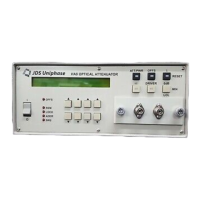Programming Guide – 58
Operation Positive Transition Register
Read with
STATus:OPERation:PTRansition? query
Written to with
STATus:OPERation:PTRansition command
Cleared by
Power-on
Condition Positive Transition Register
Read with
STATus:QUEStionable:PTRansition? query
Written to with
STATus:QUEStionable:PTRansition command
Cleared by
Power-on
Operation and Questionable Negative Transition Registers
If a bit in the negative transition register is set, then a negative transition (a transition from
1 to 0) in the associated bit in the condition register causes the associated bit in the event
register to be set.
Operation Negative Transition Register
Read with
STATus:OPERation:NTRansition? query
Written to with
STATus:OPERation:NTRansition command
Cleared by
Power-on
Condition Negative Transition Register
Read with
STATus:QUEStionable:NTRansition? query
Written to with
STATus:QUEStionable:NTRansition command
Cleared by
Power-on
Input Queue
The input queue of the attenuator is a first-in-first-out (FIFO) queue and is 100 bytes long.
Data bytes received from the controller are placed in the input queue in the order that they are
received. When a full message unit is received, it is transferred to the parser.
If the input queue becomes full while the GPIB is being used, the data acknowledge signal
(DAQ) is not sent to the GPIB controller until a character is transferred from the input buffer to
the parser. This ensures that no bytes in the program message are lost. The RS232 interface
has no DAQ signal and, therefore, cannot be signaled when the input buffer is full. If a new
program message is received before the response to a query in a previous message is read,
the output queue is cleared, MAV is set false, and the query error bit is set. This error is also
referred to as an unterminated error.
Artisan Technology Group - Quality Instrumentation ... Guaranteed | (888) 88-SOURCE | www.artisantg.com

